The 27-inch Apple iMac Review (2011)
by Anand Lal Shimpi on May 27, 2011 2:30 AM ESTThe Display
Apple offers two display options with the iMac: a 1920 x 1080 21.5-inch panel and a 2560 x 1440 27-inch panel. I tested the latter for this review.
Right away I noticed a huge difference in the default settings for the 27-inch iMac vs. my 27-inch Cinema Display. The new iMac has a lower white point, I measured 6102K uncalibrated vs. 7133K on the 27-inch Cinema Display. Here's a quick pic showing you the difference side-by-side:
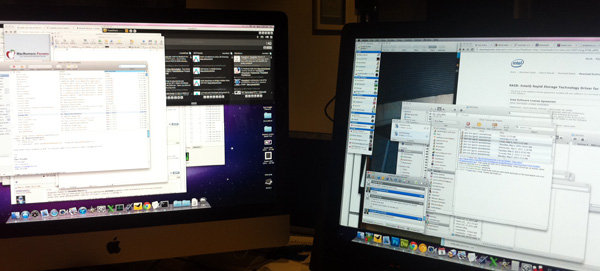
27-inch iMac (left) vs. 27-inch Cinema Display (right)
Obviously that's just a calibration issue, but it shows a little more foresight on Apple's part with the 27-inch iMac. Viewing angles seem the same between the two as well. There is a noticeable change in how Apple maps brightness levels to the software OSD on the iMac vs. the Cinema Display however. The iMac's controls are far more linear:
I'm not sure if Apple has made similar changes in currently shipping versions of the 27-inch Cinema Display but it makes a whole lot more sense now. Linear controls for non-linear curves are silly.
The change in default white point alone should be an indication that Apple is experimenting with panels or panel vendors, the rest of the data seems to back this up as well. Maximum brightness is down a bit and but so are black levels, which means overall contrast ratio remains unchanged.

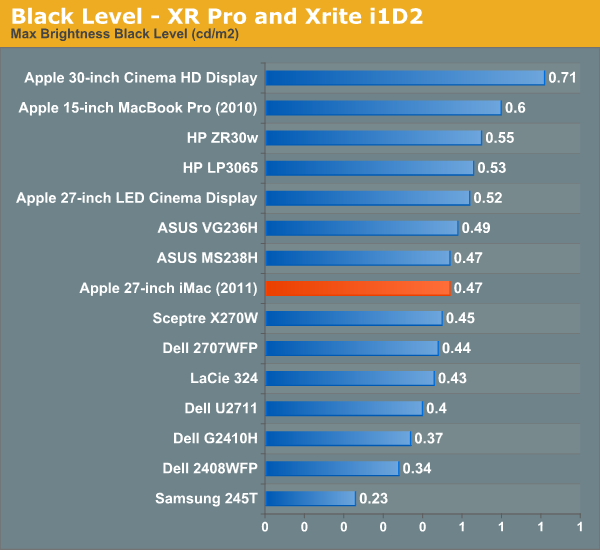
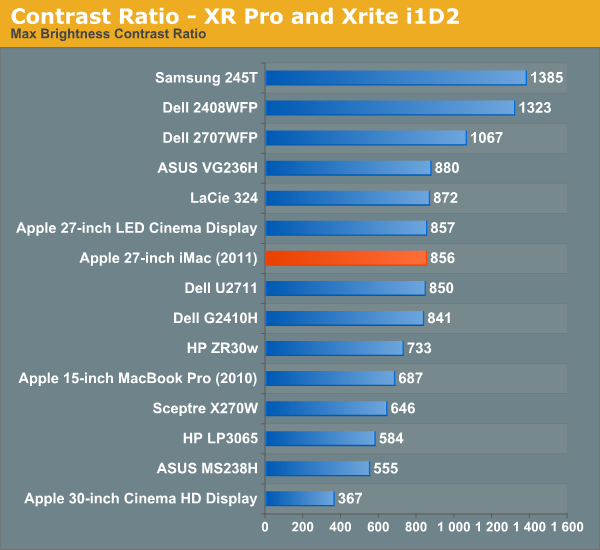
The new panel seems less uniform than the old one but it's not something that's noticeable in regular use, only if you actually measure the white/black levels on the panel.
Where the 2011 iMac does a lot better than my Cinema Display is in its color reproduction. The overall delta-E of the new panel is measurably lower than what was used in the first run of 27-inch Cinema Displays (and presumably last year's iMac):
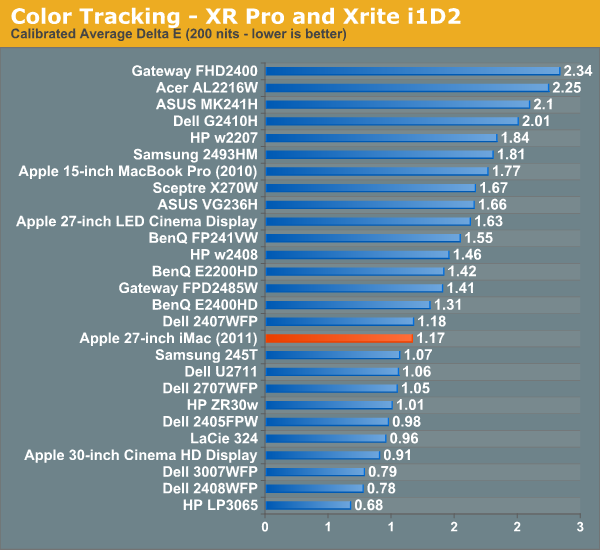
I will say that despite what you see here numerically, you'd be hard pressed to tell a difference between the two panels as long as they're both calibrated.
Color gamut is a bit worse on the new panel vs. the old one from what I can tell. Both are WLED backlit which limits the spectrum of colors they can accurately reproduce.
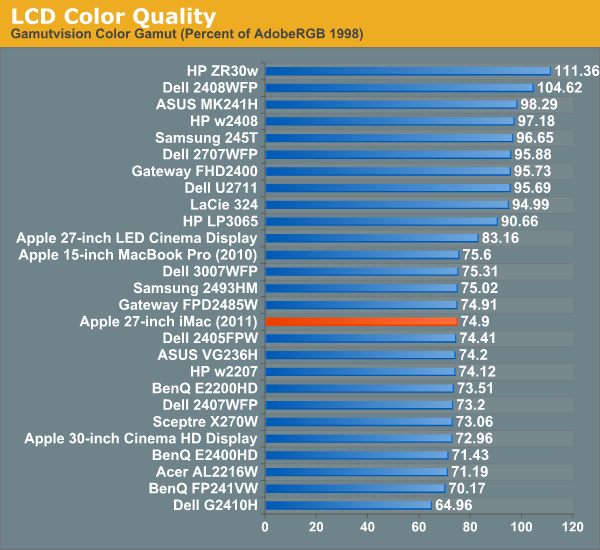
Overall I'm just as much a fan of the 27-inch iMac display as I was of the 27-inch Cinema Display. The iMac is obviously bulkier but overall desk footprint is similar and you get a Sandy Bridge system as a part of the deal.












139 Comments
View All Comments
meorah - Friday, May 27, 2011 - link
"Example: My 2007 24" imac was ~£1200. Resale value for similar spec on ebay today: ~£650-700. That means it's cost me around £500-£550 over 4 years, roughly the cost of a low-end desktop with an OK screen."its cost to you was 1200. it has depreciated around 500-550 over 4 years.
If you were trying to lease an imac for 500-550 over 4 years, then it would have cost you 500-550 over 4 years, but you bought it so that's not right.
psonice - Friday, May 27, 2011 - link
What difference does it make? At some point (probably soon) I'll sell it and buy a new box. At that point it'll have cost me 500-550, for 4 years of use.KoolAidMan1 - Friday, May 27, 2011 - link
Depreciation on PC parts is much worse. I sell my old PC components on roughly the same schedule as my Macs, every 2-3 years, and with my Mac sales it is more than enough to help pay for its replacement. With my old PC parts, not so much. :)KoolAidMan1 - Friday, May 27, 2011 - link
You nailed it. You aren't "losing a good monitor" when you sell your old iMac for a new one, you're getting a better monitor with the major revisions.The 24" iMac had a great H-IPS panel in it, but the upgrade from that to the 27" IPS panels in the new iMacs is well worth the upgrade. Combine that with high resale value on Macs and its a pretty good deal, ridiculously easy upgrade too (just pack the old one in the box it came in).
DarkShift - Saturday, May 28, 2011 - link
"Basically, macs are surprisingly cheap when you factor in the resale value. You either keep them long term (and they pay for themselves then anyway), or you sell after a few years and get half your money back."That's surpsrising considering that Mac's are mostly underpowered even as new. 650£ for 2007 iMac is way too much considering how slow it must be.
I have noticed, that most people who happily buy macs really don't know anything about tech stuff. Many still think that there must be something in Apple hardware that's better than in PC's while they often share same components.
For comparison, my self build PC workstation runs circles around these iMac's and it cost me less. And that is with Intel i7 2600K @ 4.6Ghz, 3 SSD drives,16GB ddr3 ram, Blue ray and USB 3.0 ports. And absolutely no blue screens after 5 months use. ;)
Benchmarked results:
Retouch artics Photoshop (with CS5): 9,5s
Cinebench R10 Rendering single: 7690
Cinebench R10 Rendering multi: 30536
Performance is the most important thing for pro users at it tells how fast you get your job done. Other issues are mostly cosmetic as most pro software is found for both Mac and PC. You get paid for using the tools, not for using them on specific OS.
jonwd7 - Friday, May 27, 2011 - link
Unless I am mistaken, your claim that the SSD in the 2011 iMac is the same old Toshiba one they've been using is pure speculation, but you don't treat it like so. If you attempt to order a new 2011 iMac with an SSD, the shipping date gets moved back significantly. There is some possibility that this is because they are switching to a newer, possibly Samsung-branded SSD. It being Samsung is just a rumor I believe, based on what they used in the newest MacBook Airs.kevith - Friday, May 27, 2011 - link
I think it´s not a drawback, but quite the opposite, when a laptop or an all-in-one is fitted with too little RAM and/or too little HDD/SSD, since it´s the only things you can upgrade yourself.And that always cheaper than the price-premium the manufacturer will charge, certainly if the manufacturer is Apple...
So for my part I always look for laptops without SSD and with as little memory as possible.
tech6 - Friday, May 27, 2011 - link
Looks like a nice system that is held back by a design problem. Most laptops have easy access service panels for RAM and disk upgrades or replacements and the lack of this feature would rule this system out for me. That's a pity as it looks good and is reasonable value but if you have to remove the LCD and board just to get at the disk, that is just plain stupid industrial design.Johnmcl7 - Friday, May 27, 2011 - link
It's worse than stupid, it's entirely intentional as you're not supposed to repair or upgrade your iMac you're supposed to buy a new one. I cannot stand Imacs for their appalling internal design and I'm surprised a tech site like this can still praise Imacs given that laptops a fraction of the size are a two second job to get the drive out so there's absolutely no reason for the Imac to be any different.Even putting the Imac's terrible design aside, I'm not a fan of all in one PCs as I struggle to see the point unless you're really, really tight on space. You're essentially getting the disadvantages of both a laptop and a desktop but none of the advantages as the system is neither portable nor flexible/upgradeable or offering topend performance. I have a Dell U2711 which thanks to having just about every input possible can currently hook up to a few different machines and I expect it to last far beyond the current desktop PC it's mainly hooked up to. This new Imac seems even worse for use beyond the builtin computer with a very limited video input.
John
wintermute000 - Friday, May 27, 2011 - link
The main issue is that its still laptop-esque price/performance for a desktop.The lack of an apple tower or upgradable box is quite astounding. They could just keep it single socket, 8Gb RAM or under, and consumer (not pro variant) gfx cards.
2k USD can buy you a liquid cooled quad-core sandy bridge, mid-high GPU, SSD rig + a decent 24" IPS display with a spare 4 or so Tb of spinning platter storage. No contest except for OSX tax if your apps demand OSX. Back in the XP days the OS was worth the markup but no more IMO